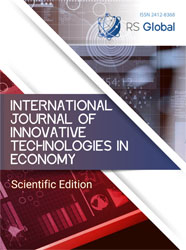ARTIFICIAL INTELLIGENCE IN BLOCKCHAIN-PROVIDE DIGITAL TECHNOLOGY
Abstract
Artificial intelligence technologies, today, are rapidly developing and are an important branch of Computer Science. Artificial intelligence is at the heart of research and development of theory, methods, technologies, and applications for modeling and expanding human intelligence. Artificial intelligence technology has three key aspects, namely data, algorithm, and computing power, in the sense that training an algorithm to produce a classification model requires significant data, and the learning process requires improved computing capabilities. In the age of big data, information can come from a variety of sources (such as sensor systems, Internet of Things (IoT) devices and systems, as well as social media platforms) and/or belong to different stakeholders. This mostly leads to a number of problems. One of the key problems is isolated data Islands, where data from a single source/stakeholder is not available to other parties or training an artificial intelligence model, or it is financially difficult or impractical to collect a large amount of distributed data for Centralized Processing and training. There is also a risk of becoming a single point of failure in centralized architectures, which can lead to data intrusion. In addition, data from different sources may be unstructured and differ in quality, and it may also be difficult to determine the source and validity of the data. There is also a risk of invalid or malicious data. All these restrictions may affect the accuracy of the forecast. In practice, artificial intelligence models are created, trained, and used by various subjects. The learning process is not transparent to users, and users may not fully trust the model they are using. In addition, as artificial intelligence algorithms become more complex, it is difficult for people to understand how the result of training is obtained. So, recently there has been a tendency to move away from centralized approaches to artificial intelligence to decentralized ones.
References
Abbasi, M. A., Memon, Z. A., Durrani, N. M., Haider, W., Laeeq, K., and Mallah, G. A. (2021). A Multi-Layer Trust-Based Middleware Framework for Handling Interoperability Issues in Heterogeneous IOTs. Clust. Comput. 24, 2133–2160. doi:10.1007/s10586-021-03243-1
Adenugba, F., Misra, S., Misra, S., Maskeliūnas, R., Damaševičius, R., and Kazanavičius, E. (2019). Smart Irrigation System for Environmental Sustainability in Africa: An Internet of Everything (IoE) Approach. Math. Biosci. Eng. 16 (5), 5490–5503. doi:10.3934/mbe.2019273
Battineni, G., Sagaro, G. G., and Chinatalapudi, N. (2020). Applications of Machine Learning Predictive Models in the Chronic Disease Diagnosis. J. Pers. Med. 10, 21. doi:10.3390/jpm10020021
Cao, J., Zhang, Q., and Shi, W. (2018). Edge Computing: A Primer,” in SpringerBriefs in Computer Science, Berlin/Heidelberg, Germany: Springer. doi:10.1007/978-3-030-02083-5_1
Ensor, A., Schefer-Wenzl, S., and Miladinovic, I. (2019). “Blockchains for IoT Payments: A Survey,” in 2018 IEEE Globecom Work GC Wkshps (IEEE).
Faroukhi, A. Z., El Alaoui, I., Gahi, Y., and Amine, A. (2020). A Multi-Layer Big Data Value Chain Approach for Security Issues. Procedia Comput. Sci. 175, 737–744. doi:10.1016/j.procs.2020.07.109
Feng, Q., He, D., Zeadally, S., Khan, M. K., and Kumar, N. (2019). A Survey on Privacy Protection in Blockchain System. J. Netw. Comput. Appl. 126, 45–58. doi:10.1016/j.jnca.2018.10.020
Hassan, M. U., Rehmani, M. H., and Chen, J. (2019). Privacy Preservation in Blockchain Based IoT Systems: Integration Issues, Prospects, Challenges, and Future Research Directions. Future Gener. Comput. Syst. 97, 512–529. doi:10.1016/j.future.2019.02.060
Meng, W., Tischhauser, E. W., Wang, Q., Wang, Y., and Han, J. (2018). When Intrusion Detection Meets Blockchain Technology: A Review. IEEE Access 6, 10179–10188. doi:10.1109/access.2018.2799854
Namasudra, S., Devi, D., Kadry, S., Sundarasekar, R., and Shanthini, A. (2020). Towards DNA Based Data Security in the Cloud Computing Environment. Comput. Commun. 151, 539–547. doi:10.1016/j.comcom.2019.12.041
Salman, T., Zolanvari, M., Erbad, A., Jain, R., and Samaka, M. (2019). Security Services Using Blockchains: A State of the Art Survey. IEEE Commun. Surv. Tutorials 21 (1), 858–880. doi:10.1109/comst.2018.2863956
van Klompenburg, T., Kassahun, A., and Catal, C. (2020). Crop Yield Prediction Using Machine Learning: A Systematic Literature Review. Comput. Electron. Agric. 177, 105709. doi:10.1016/j.compag.2020.105709
Wang, S., Ouyang, L., Yuan, Y., Ni, X., Han, X., and Wang, F-Y. (2019). Blockchain-Enabled Smart Contracts: Architecture, Applications, and Future Trends. IEEE Trans. Syst. Man. Cybern. Syst. 49, 2266–2277. doi:10.1109/tsmc.2019.2895123
Wirth, C., and Kolain, M. (2018). “Privacy by BlockChain Design: A Blockchain-Enabled GDPRCompliant Approach for Handling Personal Data,” in ERCIM-Blockchain 2018: Blockchain Engineering - Challenges and Opportunities for Computer Science Research.
Yang, R., and Yu, Y. (2021). Artificial Convolutional Neural Network in Object Detection and Semantic Segmentation for Medical Imaging Analysis. Front. Oncol. 11, 1–9. doi:10.3389/fonc.2021.638182
Yazdinejad, A., Parizi, R. M., Dehghantanha, A., Srivastava, G., and Aledhari, M. (2020). Enabling Drones in the Internet of Things with Decentralized Blockchain-Based Security. IEEE Internet Things J. 8 (8), 6406.
Zhang, M., Li, L., Wang, H., Liu, Y., Qin, H., and Zhao, W. (2019). Optimized Compression for Implementing Convolutional Neural Networks on FPGA. Electronics 8, 295. doi:10.3390/electronics8030295
Views:
413
Downloads:
286
Copyright (c) 2022 Dziatkovskii Anton

This work is licensed under a Creative Commons Attribution 4.0 International License.
All articles are published in open-access and licensed under a Creative Commons Attribution 4.0 International License (CC BY 4.0). Hence, authors retain copyright to the content of the articles.
CC BY 4.0 License allows content to be copied, adapted, displayed, distributed, re-published or otherwise re-used for any purpose including for adaptation and commercial use provided the content is attributed.











